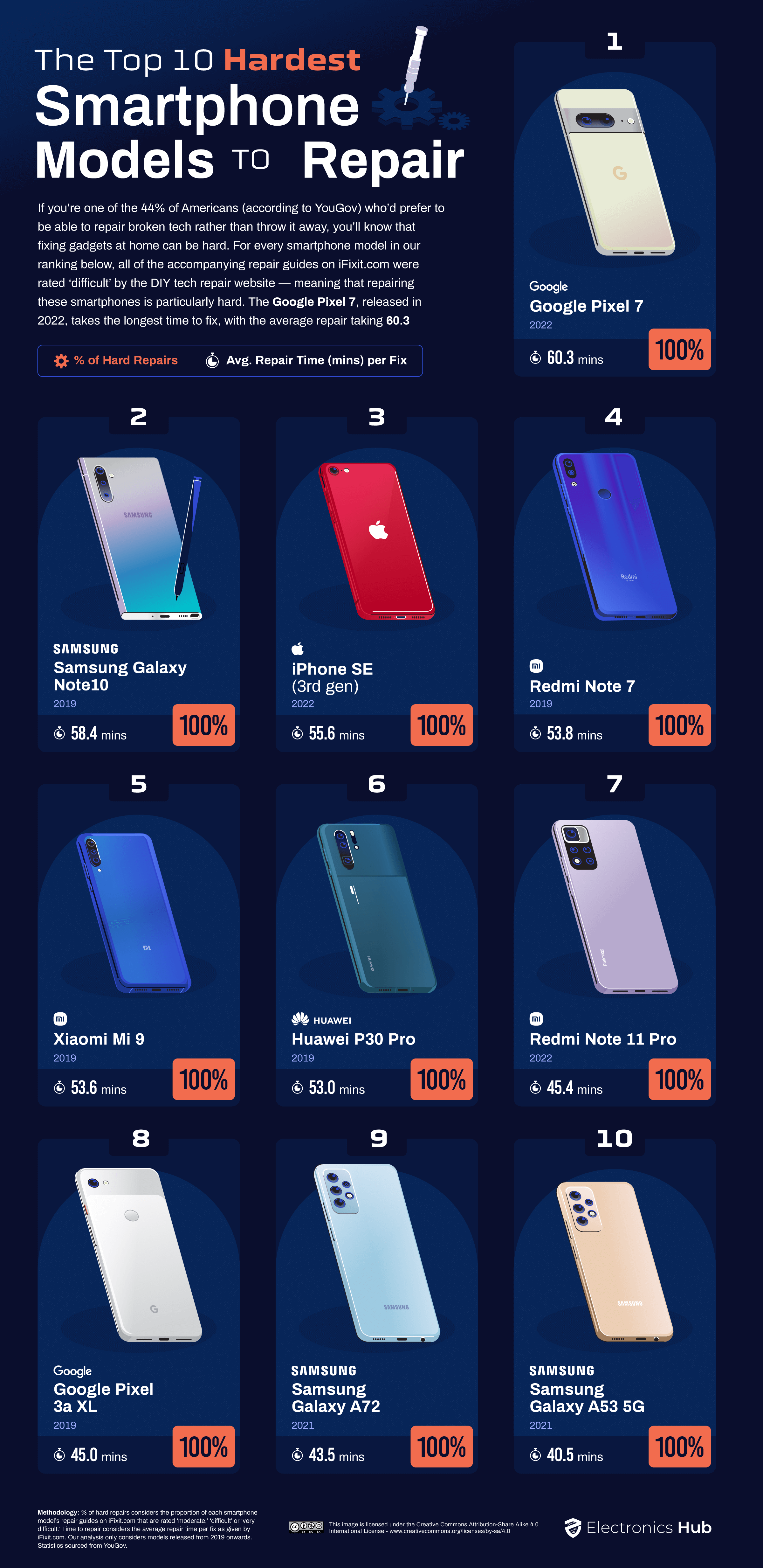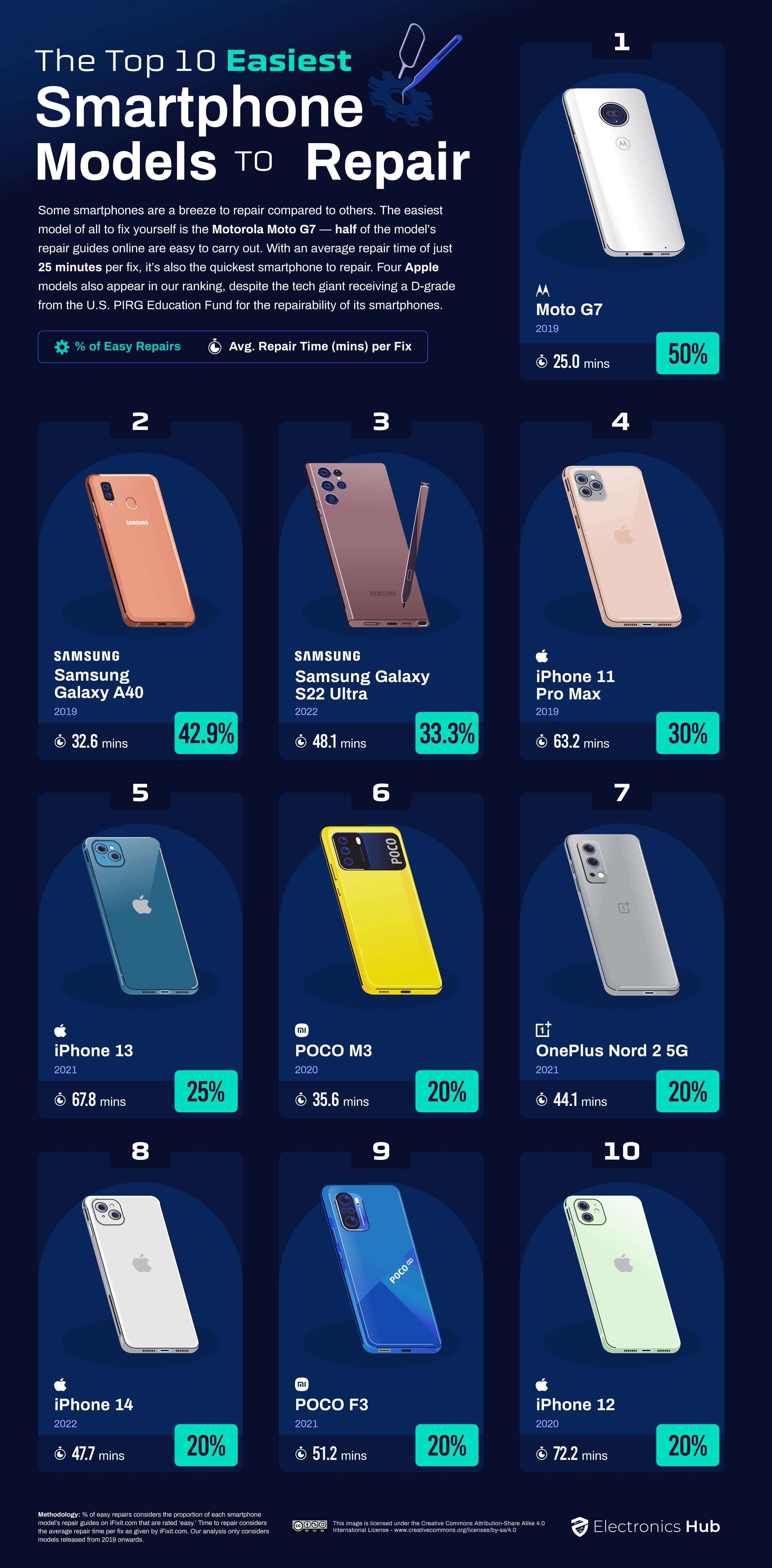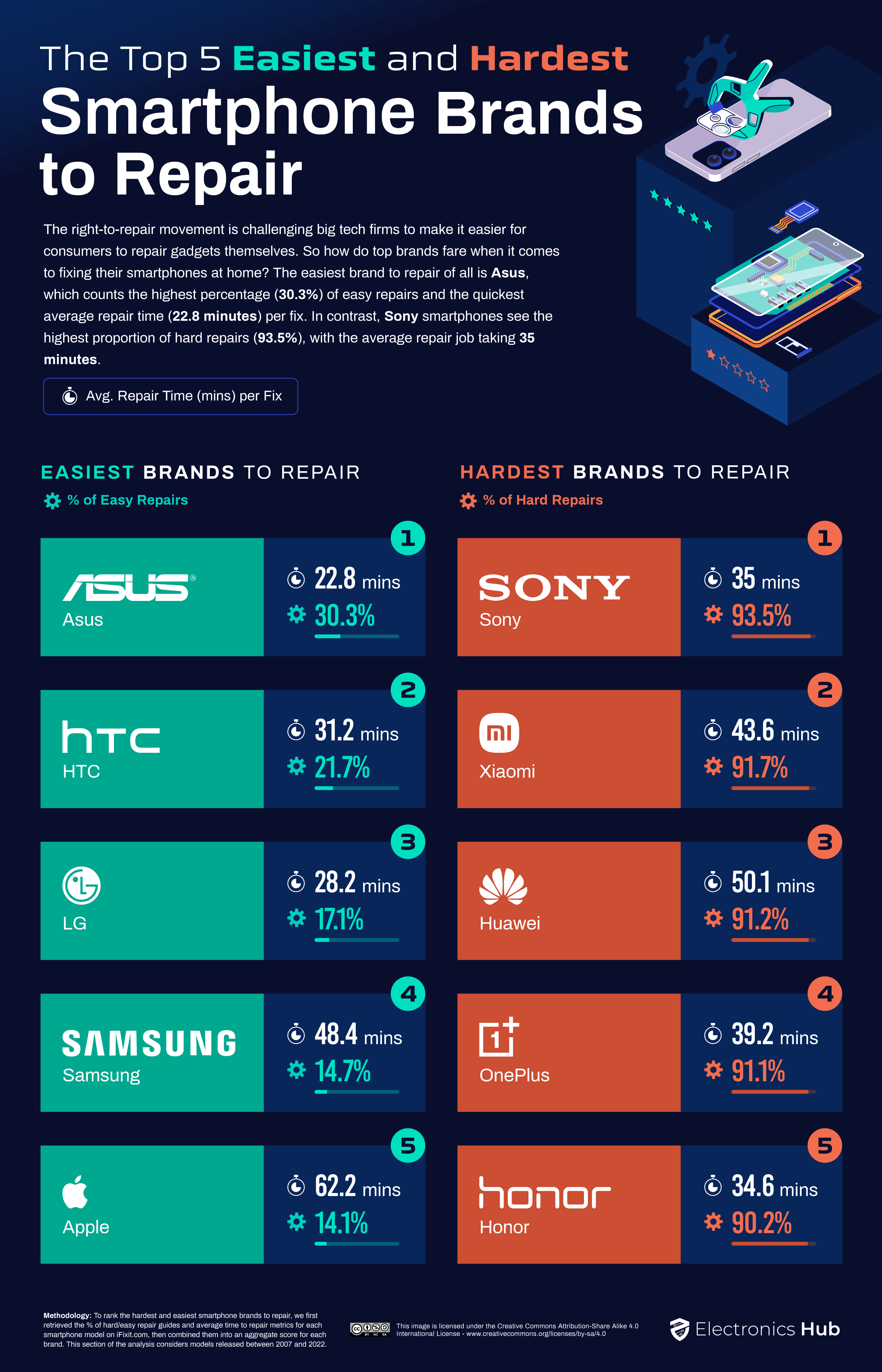
Whether it’s been dropped in a pool or the software’s glitching out, a broken smartphone is a nightmare come true for the one in two Americans who can’t imagine life without theirs. But what are your options when the worst happens?
While manufacturers tend to encourage consumers to go back to them for an official repair, high costs can be a barrier; Samsung, for example, will fix a broken screen on one of their newer models for $259 — but that’s nearly a quarter of the average American’s weekly paycheck. There’s also the issue of having to wait several days or even weeks for the phone to be sent off, fixed and returned to you — unfeasible for the 15% of Americans who rely on their smartphone for internet access.
You could take your phone to an unofficial retailer for repair, which may not break the bank as much, but it could break the gadget even more and jeopardize your warranty. The alternative — fixing your gadgets at home — is a choice championed by the Right to Repair movement, which lobbies big tech companies and legislators in the U.S. and all over the world to make it easier for consumers to do.
So which smartphones on the market are the easiest and most difficult to fix yourself? In search of answers, Electronics Hub analyzed hundreds of repair guides for 228 smartphone models on the popular DIY tech repair website iFixit. Read on to discover what we found out.
What We Did
We searched for 228 smartphone models on iFixit, analyzing the available repair guides for each. We calculated the percentage of repair guides for each phone that is rated ‘easy’ to carry out and ranked the easiest phones to fix by the highest proportion of easy fixes. Guides ranked ‘moderate,’ ‘difficult’ or ‘very difficult’ were combined to rank the hardest phones to fix. Where repair guides also had an estimated time-to-repair given, we used these times to calculate how long a repair takes on average for each smartphone.
Key Findings
- The Google Pixel 7 is one of the most difficult phones to repair and takes the longest time to repair on average (60.3 minutes)
- The easiest smartphone to repair is the Motorola Moto G7 — 50% of repairs for it are easy to do, and it’s the quickest to fix (25 minutes)
- Apple models outnumber other brands in our ranking of the easiest phones to fix yourself
- Asus smartphones are the easiest to repair overall, while Sony’s are the most difficult
Google Pixel 7 Is One of the Hardest Phones to Repair and Takes the Longest Time to Fix
With all the tiny screws, removable parts and the sinking feeling that you’ve made the problem worse, fixing a broken smartphone at home can be a challenge for even the techiest people. But which smartphones, in particular, are the most difficult to repair yourself?
To find the hardest models to fix at home, we calculated the proportion of each phone’s accompanying repair guides on iFixit that are rated as difficult. Whether the issue is a broken screen or a failing battery, all of the phones in our ranking below are difficult to repair 100% of the time. The Google Pixel 7, however, stands out as the model that takes the longest time to fix (60.3 minutes on average) — not encouraging for a phone that’s attracted criticism for easily breakable features.

Click here to see the image in full size
Despite a history of being against right-to-repair legislation, in 2022, Google gained points with the right-to-repair crowd by partnering with iFixit to make original smartphone parts available to consumers. Pixel 7 owners in France have an even better chance at getting to grips with the ins and outs of their cell phones; in 2023, the tech giant released Pixel 7 repair manuals in line with French right-to-repair laws.
Other hard-to-repair models in our ranking belong to the brands Samsung, Apple, Xiaomi and Huawei. The Samsung Galaxy Note10 is the second-hardest to fix of all, with the average repair job taking 58.4 minutes. According to GetDroidTips, common issues with this model include overheating and poor battery life, and iFixit gave this phone a repairability score of three out of 10 for tricky repair stages like un-glueing the back cover.
Motorola Moto G7 Is the Easiest Smartphone to Repair at Home
Thankfully, not every smartphone on the market is a headache to fix at home. The easiest model by far to repair yourself is the Motorola Moto G7, which not only is the quickest smartphone to fix (with the average repair job taking just 25 minutes) but can be easily fixed half of the time. One of the swiftest fixes on this device is a screen replacement, a task that takes anywhere between 10 to 20 minutes. Released in early 2019 alongside three variants (the Plus, Power and Play), the Moto G7 received fairly good reviews across the board, with TechRadar naming it the “master budget phone.”

Click here to see the image in full size
Knowing Apple’s tense history with the Right to Repair movement, it may come as a surprise to some that the tech giant outnumbers any other brand in our ranking of the easiest smartphones to repair. The iPhone 11 Pro Max, iPhone 13, iPhone 14 and iPhone 12 all make an appearance thanks to swift repair times and easy-to-follow fix guides, with the oldest iPhone in the bunch (2019’s 11 Pro Max) placing the highest. In 2022, Apple made fixing your own iPhone easier by allowing consumers to source parts, tools and manuals for specific models directly from the tech giant.
Asus Makes the Easiest Smartphones to Fix at Home, While Sony Is the Most Difficult
Thanks to the number of easy fixes and quick repair times, Asus smartphones are easier to fix at home than any other brand. Asus’ smartphone series include the ZenFone (first released in 2014) and the ROG Phone. Easy repairs are something of a theme for Asus, as their laptops (which you might associate more with the brand than cell phones) received the second-highest grade for repairability from the U.S. PIRG Education Fund in early 2023. Also appearing in our ranking is Apple, despite receiving a D-grade from the same fund for the repairability of iPhones.

Click here to see the image in full size
Meanwhile, Sony ranks as the most difficult smartphone brand to fix at home. One review of the Sony Xperia 1 III awarded the phone a repairability score of six out of 10, thanks in part to multiple layers of fiddly flex cables inside. iFixit also bestowed an earlier Sony smartphone (2016’s Xperia X Compact) with a repairability score of six out of 10, highlighting the model’s tricky adhesives and delicate NFC antenna. Three Chinese brands also rank among the most challenging to fix: Xiaomi, Huawei and Honor.
While iPhones Have Gotten Easier to Fix, Repairability of Google Smartphones Has Declined
Since the groundbreaking and crowd-pleasing release of Apple’s very first iPhone in 2007, smartphones have come a very long way. But has repairing them at home gotten easier or more difficult over the years? To find out, we charted each brand’s trend in repairability by analyzing the percentage of easy repairs for smartphones released by year.

Click here to see the image in full size
While Apple’s iPhones have seen a generally positive trend in repairability, Google’s smartphones have gotten harder, on the whole, to repair at home. Motorola sees a fairly erratic trend: while 30% of repairs for Motorola phones released in 2013 are rated ‘easy’ on iFixit, none of the repairs for 2015’s releases are easy to do. The figure jumps up again to a high of 43% in 2019 before dropping back to 7% in 2022.
Which Smartphones Are the Easiest and Most Difficult to Fix at Home?
You’re not alone if you’ve broken your smartphone — a study once revealed that the average iPhone owner manages to break their phone within 10 weeks of purchase. Then again, cell phones have a mind of their own and can also break without any human clumsiness involved. However the problem arises, we’ve calculated how easy or hard it is to fix 228 different smartphone models at home based on iFixit difficulty ratings and time-to-repair estimates. Explore our full dataset below.
In recent years, smartphones in the U.S. have gotten more and more expensive, but we’re not as willing as we used to be to fork out our precious dollars for an expensive cell phone upgrade; according to one study in 2019, only 10% of Americans said they would spend $1,000 on a new smartphone.
The increasing cost of living, too, makes fixing the phones we already have even more important, especially when brands can charge hundreds of dollars for a repair. There’s also the environment to think about, with the World Economic Forum writing that “the ability to repair phones will be key to conserving resources, tackling e-waste and climate mitigation.”
Check out Repair.org if you’re based in the U.S. and want to learn more about or get involved with the stateside Right to Repair movement.
How We Did It
To find the easiest and hardest smartphones to repair, we first created a seed list of models released by the world’s 20 most valuable smartphone brands between 2019 and 2022.
We then visited each smartphone’s model page on iFixit.com, retrieving the number of repair guides, the difficulty rating of each repair job, the number of steps involved in the repair job and the estimated time it takes to carry out the repair. Using the estimated repair time given for each repair job, we could calculate the average time it takes to repair each smartphone.
We could then rank the top 10 easiest smartphone models to repair by each smartphone’s proportion of repair guides rated ‘easy’ and, using the average repair time, how quickly it can be repaired. The top 10 hardest smartphone models to repair were similarly ranked by the proportion of repair guides rated ‘moderate,’ ‘difficult’ or ‘very difficult,’ and longer repair times.
To be included in our final rankings, a smartphone needed to have at least five accompanying repair guides from iFixit.com. When different versions of the same model range were released in the same year, we selected one model from that same year’s range to be represented in the rankings based on how easy or difficult it is to repair and the average time taken to repair it.
To find the easiest and hardest smartphone brands to repair, we considered smartphones released between 2007 and 2022. We combined the % of ‘easy’ or ‘hard ‘repair guides and ‘average time to repair’ metrics for their respective smartphone models into aggregate scores.
Our ‘ease of repair by year’ chart considers the ‘% of easy repairs’ per brand and for all brands combined. It is based on an aggregate score that combines the data for a brand’s smartphone models released each year (2007 – 2022). The same calculation is used by combining all models into one yearly score for the ‘all brands’ category.
Please note that some guides on iFixit.com did not have a ‘Time Required’ estimate, for example, this detailed repair guide and this video repair guide.
Our data was collected in January and February 2023.
Credit : Source Post






